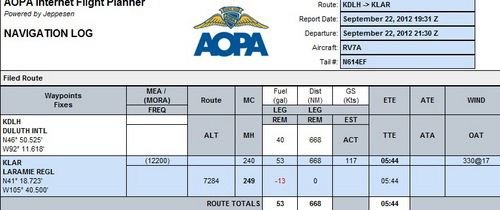The Laramie (WY) Boomerang reports that a Duluth doctor has been killed in the crash of his homebuilt airplane.
The Star Tribune identifies him as former St. Louis County medical examiner Donald Kundel, 79. The Duluth News Tribune says he had recently beaten cancer and was on his way to Laramie to celebrate on a hunting trip with his son.
I know every inch of the type of plane Kundel was flying; it’s the same type of airplane I built.
What happened?
A key may be in the FAA’s description of the crash as occurring under “known circumstances.” ( Update Sunday 3 p.m. – The FAA is making clear it was under unknown circumstances. Original reports used “known.”)That means the pilot had advised air traffic control that he had a problem. What kind of problem is impossible to say. It could be medical — a 79 year pilot flying at altitudes requiring oxygen — or it could be mechanical.
In the latter category, investigators will almost certainly look immediately at the possibility he ran out of fuel, especially since a witness reports the engine had stopped. But witness statements can be notoriously unreliable. And there are lots of things that could make an engine stop. More and more experimental aircraft use electronic ignitions, for example, and one bad alternator can quickly discharge a battery.
The RV-7A holds 42 gallons of fuel, but only about 41.5 gallons is “usable.” A pilot would normally calculate fuel usage when planning such a trip. Here, for example, is what the trip would look like (using the Weathermeister.com flight planning tool) today, given the weather conditions (click far larger view).
There’s a two-gallon penalty for headwinds and, flying west, there’s almost always a headwind.
The above flight plan, however, calculates flying at 7,500. The pilot of this flight flew at 12,500, requiring more fuel to climb to that altitude. There is, however, more fuel economy at high altitudes because of the thin air, which also requires less fuel. The destination was well within the airplane’s capability.
The Aircraft Owners and Pilots Association flight planner says at it’s likely most wasteful setting, a plane would require about 53 gallons, but that assumes a fuel-burn rate which may be higher than what the pilot might have normally experienced. Aggressive “leaning” (adjusting the mixture of gasoline and air) can change fuel consumption by as much as 40 percent. Some RV-7A pilots I’ve talked to have said they use only 5.8 gallons per hour at the higher altitude.
The flight’s data, tracked by FlightAware.com, shows that the pilot did not make a fuel stop.
But the flight data doesn’t provide any answers beyond that. The last indicated position was still 20 or so miles away from the airport. The pilot apparently had cleared mountains to the east of Laramie and was descending. Judging by the speed of his airplane at that point, his engine was working.
The first report of the crash came 8 minutes later.
It is possible the plane had “extended range” fuel tanks, which would have provided another 10 gallons of fuel.
It’s also important to remember that engine and propeller combinations can vary, even among the same model of airplane. The company that markets the plane, for example, claims the range of a tank of gas can be over 1,000 miles, but that supposes running the tanks dry.
The picture of the crash scene in the Laramie newspaper (link above) doesn’t provide much of a clue other than that although there was enough fuel to start a grass fire, there apparently wasn’t enough to burn the plane.
But even that doesn’t prove fuel exhaustion. In an emergency landing, the pilot would typically shut off the fuel supply to the engine to prevent a post-crash fire.


